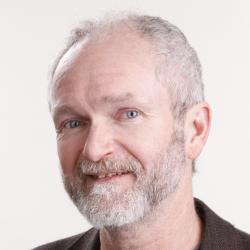Business owners and residents of the Hawley-Green neighborhood strongly object to the proposed location at James and Catherine streets and were angered by what they called a “deceitful” and “sneaky” process that did not involve the community. City officials have stepped in and say they have secured a promise from the Samaritan Center not to move until further dialogue with the neighborhood takes place.
Among the community leaders upset with the plan is Michael Desalvo, owner of Hairanoia hair salon and co-founder, along with his partner Nick Orth, of Friends of Dorothy, a hospice for people dying of AIDS, based in their home, on Wayne Street. Desalvo has been important in a mini-revival of the Hawley-Green neighborhood over the past several decades. The work of Desalvo and Orth with the indigent and dying have earned them awards and a loyal corps of supporters over the years.
Which makes this heralded couple unlikely candidates to be among those leading the opposition to a soup kitchen for the poor and the homeless. But when they learned that the Samaritan Center was planning to move its operation, which feeds up to 300 homeless men and women every day, from downtown to a location just around the corner from his home, Desalvo decided that this could tip a struggling neighborhood over the edge.
“We have done enough,” says Desalvo, a Syracuse native, sitting in the Victorian home he and Orth restored, in the shadows of James Street’s Regency Towers. “We already have the sex offenders (at the Snowdon Apartments on Burnet Avenue), we have federal halfway houses, ARISE, Ross Towers for the disabled, Syracuse Behavioral Center, subsidized housing, the Lutheran Church pantry. We’re completely surrounded, but we have worked to create balance.”
He cites a litany of problems with the proposed location at 316 Catherine Street: a lack of parking, a shortage of toilet facilities and the absence of a loading dock, among other shortcomings.
Beyond that, he complains, the Samaritan Center failed to communicate its intentions to the neighbors. Like many others in Hawley-Green, Desalvo resents that the project was put in motion without the community being asked or engaged.
“She (Samaritan Center executive director Mary Beth Frey) started doing everything sneaking behind our backs. No public hearings. Back-door bullying, deceit: It isn’t showing compassion,” he says.
Michael LaFlair, executive director of the North East Hawley Development Association (NEHDA), got wind of the Samaritan Center’s intent to move when the issue appeared on the agenda of a Neighborhood Watch meeting scheduled for Aug. 20 at NEHDA’s headquarters on Gertrude Street.
“I heard about it in mid-August. I reached out to them; they didn’t call me,” says LaFlair. “The day of the meeting was the first I heard about the project. I was a little upset.”
Many neighbors in attendance at that meeting heard about the project for the first time. “That’s where the initial shock and anger came about,” says LaFlair.
Two days later, on Aug. 22, the city’s Zoning Appeals Board approved a minor change to a modification for the use of the property, without a public hearing. In a five-page brief dated Aug. 8, prepared by the law firm of Hiscock and Barclay, the Samaritan Center argued that 316 Catherine St. had been used for similar purposes in past years. The board agreed.
The building had been home to a number of helping agencies in the past, including the Living Room, a drop-in center for people with HIV, and SAGE, which maintained a meeting place for elderly gay and lesbian people. Those operations, Desalvo points out, and Frey acknowledges, served dozens of people, not the hundreds that Samaritan feeds every day.
“It’s up in the air,” said Frey, the Samaritan Center’s executive director, when asked about the plans. “We want to keep dialogue going.”
The center opened its doors in the basement of St. Paul’s Cathedral in 1981 as a joint project of seven downtown churches determined to feed the needy. Today, the program involves 130 churches. With a staff of six, and hundreds of volunteers, it serves food and offers case management services to thousands every year. In 2012, it served 120,000 meals, a 31 percent increase over five years.
Two years ago, center managers recognized that it had outgrown the space at St. Paul’s and began to look for a new home that would be larger, accessible to the handicapped and more friendly to children. A subcommittee of the center’s board reviewed 28 properties and settled on the 6,500-square-foot facility on the first floor of 316 Catherine St.

“We want to be as respectful as we can of the neighborhood,” said Frey.
Most of her outreach, she acknowledged, had been conducted with businesses and agencies along James Street, not in the Hawley Green neighborhood directly south of James. “As far as understanding the neighborhood context, I need to understand that more.”
“There was no mal intent, we weren’t trying to hide anything in any way,” says Frey. “Obviously, they feel they weren’t communicated with, and I regret that. If there was a misunderstanding, then I want to dialogue with the neighbors.”
Cindy Seymour, who owns Laci’s Tapas Bar at 304 Hawley Ave., is angry and not interested in dialogue. She and her partner, Laura Serway, have hired an attorney, Joseph Cote, who is planning to sue the city for giving approval to the project without a public hearing.
“This was a new use, not a continuation of a previous use,” says Cote. “We will have hundreds of plaintiffs, and the Samaritan Center will have to restate their position in public.”
Seymour says she had one face-to-face meeting with Frey, on Aug. 28, after the zoning board approved the change.
“I was very adamant,” Seymour says. “As far as I’m concerned, I don’t want you in my neighborhood, because of how the relationship started, with deceit. The fact that they didn’t reach out was deceitful.”
“I oppose this project 100 percent,” says Seymour. “We are saturated. We fight the battle every day to keep prostitutes and drug dealers and panhandlers at bay. We can’t keep them out, but we can keep them at bay.”
Seymour says she and Serway offered to buy a suitable building to house the Samaritan Center, but Frey rejected the offer.
“We said, ‘We’ll buy a building so you can lease it, and we’ll keep the dollars local instead of paying a landlord in Rochester,’” said Seymour. “She wouldn’t even entertain it.”
Andrew Maxwell, Syracuse-Onondaga County planning director, is the city’s point person dealing with the matter. He still hopes that a solution can be found.
“Everyone’s intentions are good,” says Maxwell, who has met with all parties involved. “It’s challenging and complicated, which is why we encourage dialogue.”
A Sept. 23 meeting is scheduled at Laci’s, and Maxwell says the Samaritan Center has promised not to proceed before then.
“It’s important to understand the commitment that people have to their neighborhood,” said Frey. “They have a commitment to create a vibrant neighborhood.”
What can the neighbors do to stop the project? “There aren’t many hurdles that they need to pass,” after the Zoning Board ruled, says Maxwell, the man in the middle. “Just a few permits, and that’s usually pretty straightforward. ”
The Samaritan Center has not yet signed a lease with the building owners, the Courtyard at James LLC, which is based in Rochester.
“We are trying to make sure that the foundation of our mission is something we are honoring,” says Frey. “We are still looking to find that right spot. Catherine Street had, has a lot of positives, but there are a lot of hurt feelings that I never intended.” Frey emphasizes that the Samaritan Center does not just feed the homeless. “We have more and more people who are working, teetering on the edge of poverty, and trying to feed their family. We serve veterans, senior citizens with limited income.”
LaFlair, the NEHDA executive director, is hoping that a compromise might still be found. “We’ve met with them,” says LaFlair. “All indicators are that they are open to figuring out a solution.”
But Cindy Seymour does not expect much will come out of dialogue.
Desalvo tells war stories of harassing landlords to deal with noisy tenants in properties near his salon and finding services for disruptive neighbors with mental health issues.
“Now, instead of seeing drug dealers and loitering on the porches, you see families going by with strollers and kids playing. We are rising up–we can’t do everything in our neighborhood. If anyone remembers what our corner was like 15 years ago, is that what they want to return to?” he asks.
“We take care of a lot of people in this neighborhood. This not about gentrification, it’s about saturation. We can’t handle this type of influx. It’s unfair. We want a balance. We have a right to say ‘enough.’



